
Features
Business
Policy
Trapping water from nature helps P.E.I. potato producers
from nature helps P.E.I. potato producers
March 7, 2008 By Kathy Birt
Prince Edward Island farmers have come to realize in recent years
that they shouldn’t depend on the weather to provide adequate rainfall
to produce better yields and high quality crops.
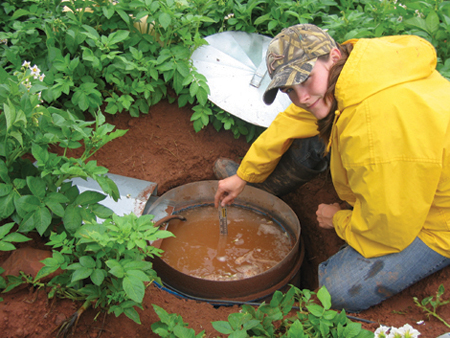 |
| Guenna McCarthy, a Masters student with the Nova Scotia Agricultural College, checks one of the run-off collection barrels following a heavy rain event. This was the barrel used to monitor the test area that received the Spudnik treatment. Contributed photo |
Prince Edward Island farmers have come to realize in recent years
that they shouldn’t depend on the weather to provide adequate rainfall
to produce better yields and high quality crops.
With a mandate to address possible droughts and water shortages, the Canada-Prince Edward Island Water Program contributed $97,000 towards a project aimed at maximizing the benefits of rain provided by Mother Nature in producing potato crops.
An application was put forth by Ron DeHaan, manager of the Sustainable Agriculture section of the P.E.I. Department of Agriculture (Fisheries and Aquaculture) for this project.
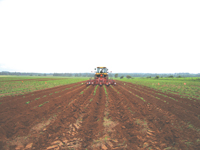 |
| Field research conducted by the P.E.I. Department of Agriculture (Fisheries and Aquaculture) evaluated potato crop hillers, including the Spudnik hiller with a rear prop attachment, and what effect this equipment would have on field run-off rates. Contributed photo |
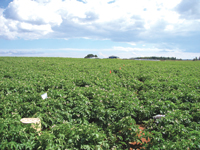 |
| McCardle Brothers potato farm in Middleton, P.E.I., was one of the farms involved in the project during the summer of 2006. It was the first time in 30 years the farm didn’t have to use the irrigation system to nourish the potato crop. Contributed photo |
The funding, along with in-kind money from the department, is being used to evaluate three hillers in potato fields. These include the traditional one-pass conventional hiller, an older cultivator spade-type hiller and the Spudnik hiller with a rear prop attachment that creates small dams and ponds in furrows with approximately 18-inch centres.
“We are comparing the run-off rates and moisture retention levels in the hills formed by the three hillers,” explains DeHaan, adding that adequate soil moisture has been a limiting production factor in recent years.
“If runoff can be reduced by keeping rainwater on the field, this would reduce the requirement for supplemental irrigation,” he says. This should result in a positive impact on potato yield and quality, he adds.
The traditional one-pass hiller creates compacted furrows that become “racetracks” for runoff, DeHaan explains. “If we get a really intense thunder storm event during the summer, these compacted furrows transport a lot of runoff which has in the past contaminated water courses with silt, nutrients and agri-chemicals.”
A number of hillers were compared in a previous research trial on P.E.I. using a rainfall simulator. Results indicated that run-off time could be increased by 25 times with the Spudnik and the rear attachment, compared to the conventional one-pass hiller. Hence, less chance for erosion from the field carrying silt, nutrients, and chemicals into nearby streams and rivers. DeHaan also notes that the rainfall simulator results do not account for raindrop impact or the cumulative effect of repeated rainfall events over an entire growing season.
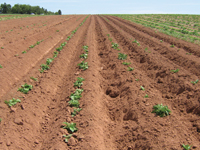 |
| The photos show the furrow dams created by the Spudnik hiller after its first pass in the potato field. Contributed photos |
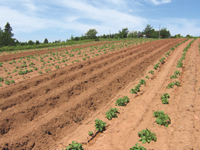 |
He says before the technology is recommended to producers, it was felt that it should be evaluated on a field scale. “Two commercial potato fields were selected for each year of the current study and these fields had to meet a number of criteria,” DeHaan says, adding, “ The fields had to have a similar soil type, which represented soils that potatoes are commonly grown in the province.”
Other criteria included:
• Fields picked had to have a three-year potato/cereal/forage rotation;
• they had to have similar organic matter levels;
• a portion of the field had to have a three- to five-per-cent slope in the
direction in the direction the field was being farmed; and
• one field per year had to have the capability of being irrigated with a
pivot irrigation system; the second with a Reel irrigation system.
“If irrigation was required during the summer, the project would have the capability of comparing runoff under the two most commonly used irrigation systems (in P.E.I.),” says DeHaan.
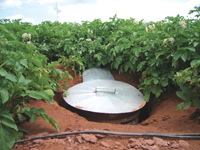 |
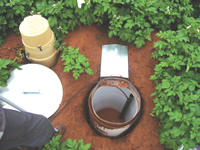 |
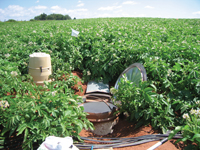 |
| These run-off collection barrels were used in all of the research trials and were monitored by Guenna McCarthy, a Masters student with the Nova Scotia Agricultural College (NSAC), during the summer of 2006. Due to the level of rainfall that summer, irrigation monitoring wasn’t possible. Contributed photos |
The 2006 growing season was the first year for the project for DeHaan and his assistants, Gwen Corrigan-Vessey and Guenna McCarthy. Corrigan-Vessey, a soil conservation officer with the Sustainable Agriculture Section, had the role of selecting fields, order monitoring equipment and provide technical support. McCarthy, a Masters student with the Nova Scotia Agricultural College (NSAC) filled the role of installing the monitoring equipment and also collected and analyzed data.
“Last year went pretty well,” says McCarthy. “We had a number of heavy rainfall events and the data showed a significant difference in runoff
between the Spudnik and the conventional type hillers.”
She explains that in one particular event, 65 millimetres of rainfall was received over a two-day period. Runoff from the 75-foot length of row filled 45-gallon drums that were installed in the furrows of the conventionally hilled treatments.
“This compared to just two inches of runoff in the bottom of barrels with the Spudnik treatment,” says McCarthy.
Overall, during 2006, there was adequate rainfall throughout the growing season, therefore the results show there were no measurable differences between the various hillers on soil moisture levels. “In a dry season when there is a moisture stress, we would hope to see a difference between the Spudnik and the other treatments,” says McCarthy.
McCardle Brothers potato farm in Middleton, P.E.I., was one of the farms involved in the project during the summer of 2006. Despite the fact it was a rainy summer and the farm’s irrigation system wasn’t required, “it was a very good project as far as assessing new equipment and we were able to cooperate with Guenna as far as monitoring yields,” says Leonard McCardle, adding it was the first time in 30 years he had not had to use the irrigation system.
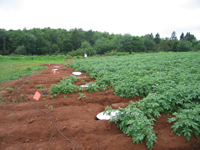
|
| This photo shows a side view of the numerous plots with a section of the collection barrel peeping through the plant foliage. There were nine trials, three treatments with three repetitions. Contributed photos |
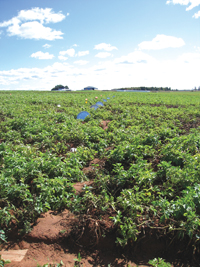 |
With or without irrigation, McCarthy notes that the same monitoring was carried out; however, “there was no opportunity to do comparisons (on farm irrigation systems).”
For 2007, soil moisture sensors have been installed in all three treatments and if a prolonged dry spell is experienced, there will be opportunity to measure the impacts of the hillers on the soil moisture.
Other areas to be explored during collecting of data and carrying out of the research include analyzing the runoff (for) sediments, nutrients and pesticides.
“We are also looking at the integrity of the ponds created by the Spudnik after repeated rainfall events,” explains McCarthy. “Are they effective for the entire growing season?”
“The preliminary data suggests that the effectiveness of the ponds may actually decrease as the season progresses,” explains Corrigan-Vessey.
DeHaan says the Spudnik hiller with the rear attachment is simple technology that can be readily adapted and adopted by the potato producers. “If the results from this experiment show that runoff can be significantly reduced over the entire growing season, the producer will realize some benefits from improved moisture retention and there will be positive impacts on the environment.”
Print this page